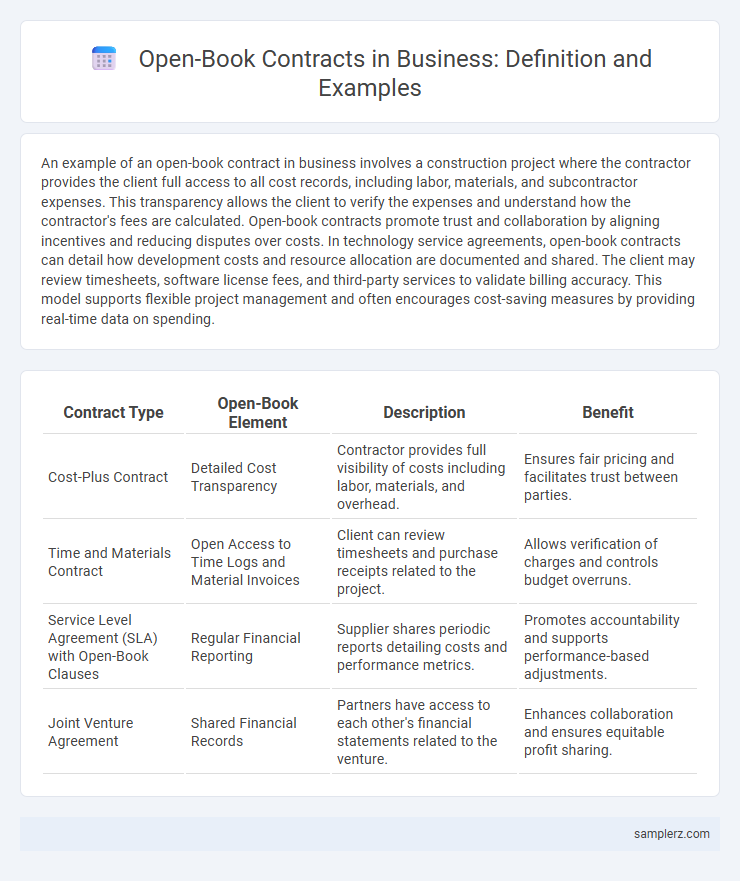An example of an open-book contract in business involves a construction project where the contractor provides the client full access to all cost records, including labor, materials, and subcontractor expenses. This transparency allows the client to verify the expenses and understand how the contractor's fees are calculated. Open-book contracts promote trust and collaboration by aligning incentives and reducing disputes over costs. In technology service agreements, open-book contracts can detail how development costs and resource allocation are documented and shared. The client may review timesheets, software license fees, and third-party services to validate billing accuracy. This model supports flexible project management and often encourages cost-saving measures by providing real-time data on spending.
Table of Comparison
| Contract Type | Open-Book Element | Description | Benefit |
|---|---|---|---|
| Cost-Plus Contract | Detailed Cost Transparency | Contractor provides full visibility of costs including labor, materials, and overhead. | Ensures fair pricing and facilitates trust between parties. |
| Time and Materials Contract | Open Access to Time Logs and Material Invoices | Client can review timesheets and purchase receipts related to the project. | Allows verification of charges and controls budget overruns. |
| Service Level Agreement (SLA) with Open-Book Clauses | Regular Financial Reporting | Supplier shares periodic reports detailing costs and performance metrics. | Promotes accountability and supports performance-based adjustments. |
| Joint Venture Agreement | Shared Financial Records | Partners have access to each other's financial statements related to the venture. | Enhances collaboration and ensures equitable profit sharing. |
Understanding Open-Book Contracts in Business
Open-book contracts in business involve transparent sharing of cost details between clients and contractors, enabling real-time tracking of expenses and fostering trust. This approach typically includes access to invoices, labor rates, and material costs, ensuring accountability and collaboration in project management. Companies adopting open-book contracts often experience improved budget control, reduced disputes, and enhanced partnership efficiency.
Key Features of Open-Book Contract Agreements
Open-book contract agreements emphasize transparency by granting clients full access to the contractor's cost data, including labor, materials, and overhead expenses. These contracts foster a collaborative environment where both parties share risks and benefits through real-time financial disclosures and joint decision-making. Key features include detailed cost tracking, agreed-upon pricing formulas, and regular audit rights to ensure accuracy and trust throughout the project lifecycle.
Benefits of Open-Book Contracts for Stakeholders
Open-book contracts foster transparency by allowing stakeholders to access detailed project costs and financial records, enhancing trust among clients, contractors, and suppliers. This transparency helps identify cost savings and inefficiencies, leading to more accurate budgeting and reduced financial risks. Stakeholders benefit from improved collaboration and accountability, resulting in higher project quality and timely delivery.
Common Industries Utilizing Open-Book Contracts
Common industries utilizing open-book contracts include construction, manufacturing, and engineering, where transparency in costs is crucial for project management and budgeting accuracy. In construction projects, open-book contracts allow clients to access detailed expense records, fostering trust and collaboration between contractors and stakeholders. Manufacturing sectors benefit from this approach by minimizing disputes through clear visibility of material and labor costs, enhancing overall efficiency and accountability.
Comparison: Open-Book vs. Fixed-Price Contracts
Open-book contracts provide transparent access to a contractor's cost records, enabling clients to verify expenses and closely monitor project budgets, which contrasts sharply with fixed-price contracts where a predetermined sum is agreed upon regardless of actual costs. Open-book agreements foster collaboration and flexibility, allowing adjustments based on real-time financial data, while fixed-price contracts transfer risk primarily to the contractor, often leading to conservative pricing. The choice between open-book and fixed-price contracts depends on project complexity and risk tolerance, with open-book preferred for projects requiring transparency and adaptability.
Example Case Study: Open-Book in Construction Projects
Open-book contracts in construction projects foster transparency by allowing clients full access to the contractor's cost records, enabling precise budget tracking and risk sharing. For example, the Sydney Airport Terminal 1 Expansion used an open-book approach, where project stakeholders reviewed real-time expenses and collaborated on cost-saving strategies, resulting in a 15% reduction in projected costs. This model improves trust and accountability, driving efficient resource management and timely project delivery.
Essential Elements of an Open-Book Contract
An open-book contract requires full transparency of costs, including detailed breakdowns of labor, materials, and overhead expenses, ensuring trust between parties. Clear definitions of allowable and disallowable costs establish accountability and prevent disputes over billing. Regular audits and shared access to financial records are essential elements that maintain integrity and enable collaborative cost control throughout the project lifecycle.
Risks and Challenges in Open-Book Contracting
Open-book contracting exposes both parties to financial transparency, which can risk sensitive cost data being misused or misunderstood, potentially leading to disputes over project budgeting. Challenges include maintaining trust and managing increased administrative workload to ensure accurate and timely sharing of financial information. Without clear guidelines and communication, open-book contracts may result in disagreements about allowable expenses and profit margins, impacting project outcomes.
Best Practices for Managing Open-Book Contracts
Transparent cost reporting is essential for successful open-book contracts, enabling clients to verify expenses and reduce disputes. Establishing clear communication protocols ensures all stakeholders access real-time financial data, fostering trust and accountability. Regular audits and agreed-upon key performance indicators (KPIs) guarantee contract compliance and continuous improvement in project delivery.
Real-World Examples of Open-Book Contracts in Business
Open-book contracts in business are exemplified by large construction projects, such as the Denver International Airport expansion where transparency in costs helped align contractor and client goals. Technology firms like IBM employ open-book agreements to foster trust and collaboration in long-term service contracts, revealing detailed expense reports and profit margins. Manufacturing partnerships, including Toyota's supplier contracts, also utilize open-book practices to streamline cost management and promote shared efficiency gains.

example of open-book in contract Infographic
 samplerz.com
samplerz.com